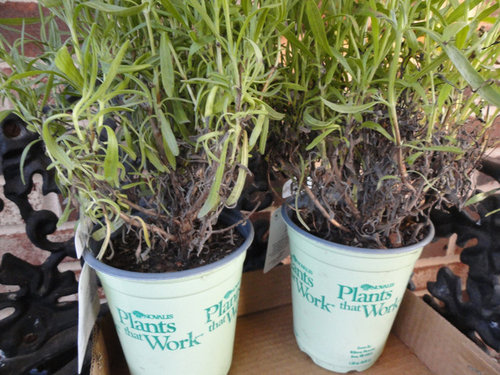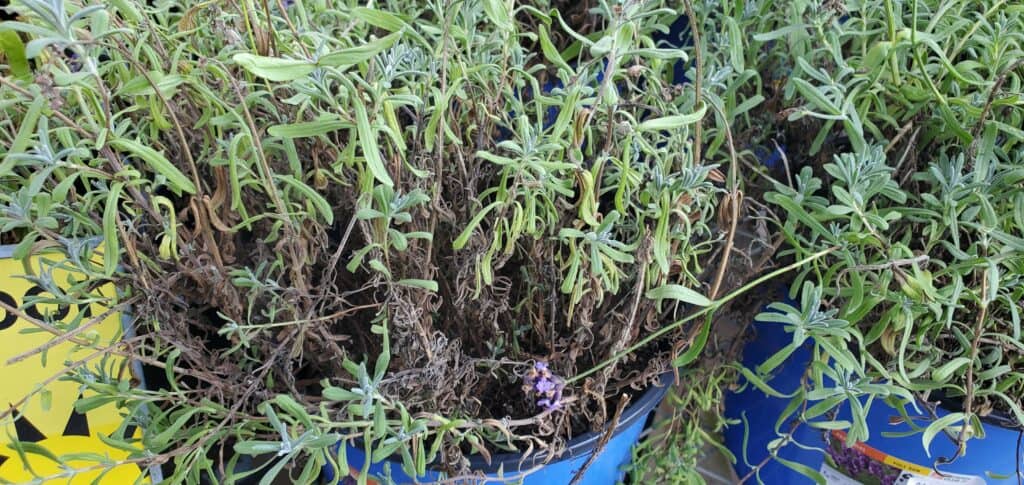
Lavender blooms may become brown as a result of frost damage, a fungus (caused by moist soil), or a natural process when the flowers mature into seed heads.
A fungal illness is probably present if the foliage is also becoming brown. A late frost may harm the delicate flowers if the leaves appear intact, but the petals are going dark and need to be deadheaded to encourage new blooms.
Continue reading to find out the cause of your lavender flowers turning brown, whether it needs any attention, and how to fix it.
Table of Contents
1. Brown Lavender Flowers Due to OverWatering or Poor Drainage
Browning of lavender flowers (and foliage) is an indication of stress brought on by overwatering, inadequate soil drainage, or possibly a pot without adequate drainage holes in the base.
Lavenders are indigenous to Mediterranean regions, which feature sandy soil, scorching summer sun, and little to no rain or irrigation.
All lavender species are specialized to surviving in dry, sandy or stony soils with low to medium nutrition, with the exception of those (like English lavenders and Intermedia lavenders) that can endure freezing climes.
The risk of fungus and root rot increases if the lavender is planted in soil that retains water, such as clay, or perhaps compost that retains a lot of moisture.
Another sign of a fungus infection is the lavender plant looking droopy.
In terms of blossoms and scents, lavenders thrive in soil that drains well, and their roots prefer to be kept dry in between waterings.
You are probably overwatering your lavender if you give it a drink more frequently than once every two weeks.
Lavenders flourish in dry settings and don’t need nearly as much watering as the majority of plants in a regular garden because they are heat and drought hardy.
When lavender is established, it is crucial to maintain well-draining soil (with lots of sand or grit) and water sparingly, if at all, as the fungus disease pathogens that attack lavender thrive in moist soils.
(For further information, see my post on how frequently to water lavender.)
Lavender plants frequently receive more water than they need from rainfall and don’t need any additional watering. This is especially true in temperate climates with rainy periods and cloudy days.
The answer is…
- Even in warmer weather, reduce the frequency of watering your lavender to once every two weeks to allow the roots to completely dry out between applications.
- Add horticultural sand or grit to the soil to amend it. In order to replicate the conditions of the lavender’s natural environment, this will enhance soil drainage and guarantee the proper balance of nutrients in the soil.
- The lavender plant is probably being attacked by a fungus if the foliage has turned noticeably brown in addition to the blooms. Check the roots of the lavender plant by removing it from the ground or pot. If the roots appear brown and feel rotten, cut them off with a pair of sterile pruners and get rid of any brown areas of the lavender plant.
Depending on the severity of the damage, lavender plants with a lot of brown foliage and flowers may not survive.
However, after they are planted in a more suitable soil profile with greater drainage and the watering is greatly decreased, lavenders with brown blooms can frequently recover.
(Read my post for more details on how to handle fungal illness in lavender.)
Additionally, it’s crucial to grow lavender in a container with drainage holes on the bottom to let excess water drain; otherwise, the soil will stay damp and provide a higher danger of fungus. To choose the finest pots for lavender plants, see this post.
However, as long as they are in full sun and you choose a cold hardy species like English lavender (Lavandula angustifolia) or (Lavandula x intermedia) lavender for your garden, they do not necessarily need the high Mediterranean temperatures and mild Winters. Lavender does, however, require some of the growing conditions of its native Mediterranean to grow healthy and produce healthy flowers.
(To find out how to mix the ideal soil for lavenders, read my post.)
2. Late frost in the Spring
This is especially true of the early flowering types, which are more susceptible to frost and bloom earlier in the season than the English and intermedia varieties. Examples of these include French and Spanish lavender.
The remedy…
English (Lavandula angustifolia) and (Lavandula x intermedia) lavenders are far more cold hardy (hardy to USDA 5), and they will survive Winter tolerating snow and freezing temperatures whereas Spanish and French lavenders typically only last one season without a mild Winter climate. If you live in a climate with cold winters, I recommend planting English (Lavandula angustifolia) and (Lavandula x intermedia) lavenders.
‘Hidcote’ and ‘Munstead’ lavender cultivars are excellent choices for cold-tolerant English lavenders and provide a coveted sweet perfume.
If the frost-damaged flowers have turned brown, cut them off; the lavender shouldn’t be seriously harmed, and this will boost the likelihood of new blossoms later in the summer.
3. Flowers Turn Brown up to Three Times per Year

| Purple Species | During its bloom |
| There are two types of English lavender (Lavandula angustifolia): Hidcote and Munstead. | 4 weeks usually in June. |
| Varieties of (Lavandula x intermedia) include “Grosso,” “Phenomenal,” and “Provence.” | Depending on the climate, flowers last into the fall. |
| Lavenders (Lavandula dentata) from France and Spain (Lavandula stoechas) | With multiple blooming periods continuing until the fall, May/June. |
In the Spring, Summer, and even the Fall if you live in a warmer climate with mild temperatures, the French, Spanish, and Lavandula x intermedia varieties all frequently bloom up to three times.
Each time it blooms, the flowers will survive for about a month before turning brown on their own and needing to be deadheaded to encourage new blooms.
Do not be frightened if some flowers start to turn brown while others are still purple and appear healthy; this is a natural occurrence.
Throughout the growth season, simply deadhead the lavender plants with a pair of pruners to encourage more blooms.
If the brown blossoms are not removed, they will develop into the seed heads that rattle when the lavender plant is shaken. If you wish to cultivate fresh lavender plants, this is certainly a fantastic technique to harvest the seeds. However, it is far simpler to propagate lavender through cuttings than from seed.
English lavenders flower for a shorter period of time than other types of lavender, but they are far more cold tolerant (hardy to USDA zone 5 and enduring frost in winter), live longer than French and Spanish varieties, and have a much richer and sweeter aroma in the leaf.
Because deadheading shifts the plant’s energy from creating seeds to developing new flower buds and presenting more flowers, it stimulates additional flowers on lavender plants.
(Read my post on how to grow lavenders in pots and containers for the best maintenance tips.)
